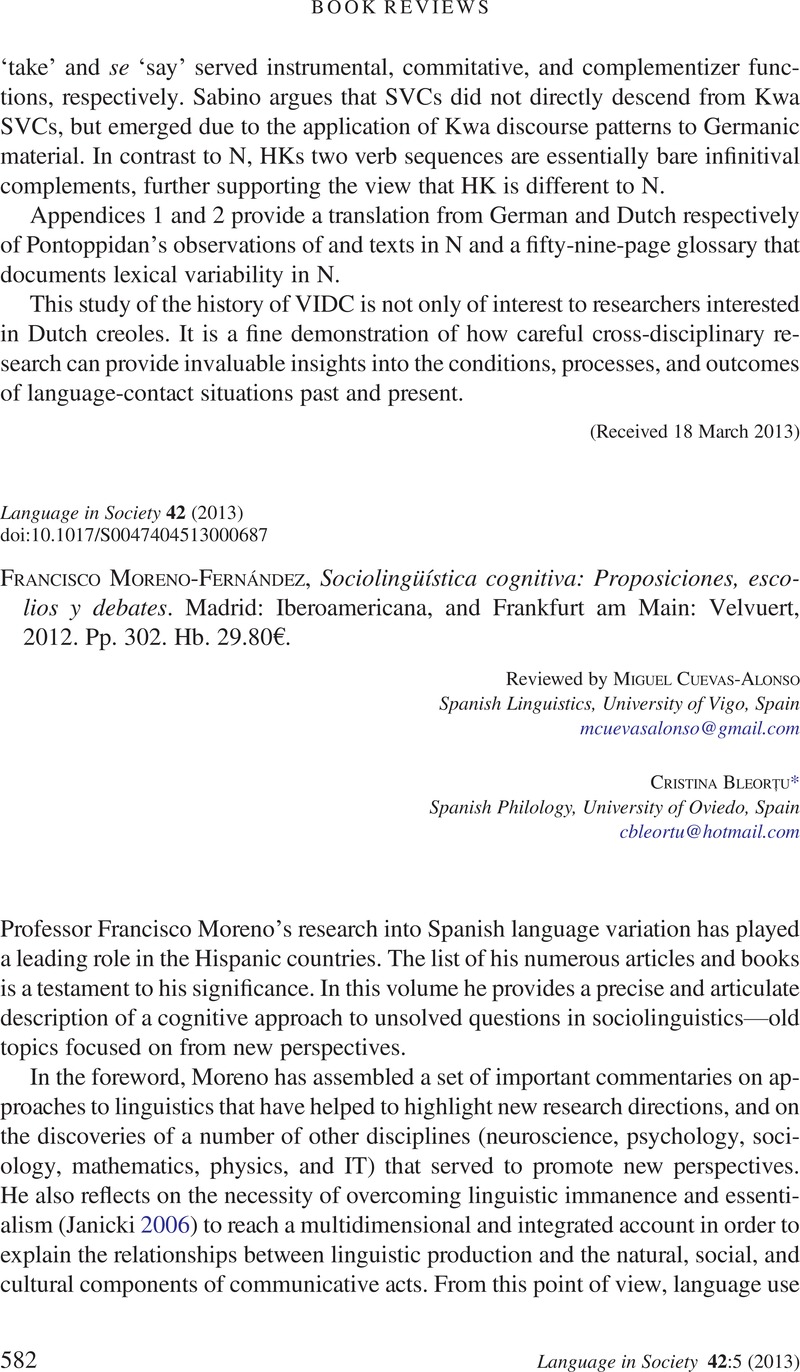No CrossRef data available.
Article contents
Francisco Moreno-Fernández, Sociolingüística cognitiva: Proposiciones, escolios y debates. Madrid: Iberoamericana, and Frankfurt am Main: Velvuert, 2012. Pp. 302. Hb. 29.80€.
Published online by Cambridge University Press: 11 October 2013
Abstract
An abstract is not available for this content so a preview has been provided. Please use the Get access link above for information on how to access this content.

- Type
- Book Reviews
- Information
- Copyright
- Copyright © Cambridge University Press 2013
References
Bod, Rens; Hay, Jennifer; & Jannedy, Stefanie (eds.) (2003). Probabilistic linguistics. Cambridge, MA: MIT Press.CrossRefGoogle Scholar
Bybee, Joan (2001). Phonology and language use. Cambridge: Cambridge University Press.CrossRefGoogle Scholar
Bybee, Joan (2010). Language, use and cognition. Cambridge: Cambridge University Press.CrossRefGoogle Scholar
Clark, Andy (1997). Being there: Putting brain, body and world together again. Cambridge, MA: MIT Press.Google Scholar
Damasio, Antonio (1999). The feeling of what happens: Body and emotion in the making of consciousness. New York: Houghton Mifflin Harcourt.Google Scholar
Gallagher, Shaun (2005). How the body shapes the mind. Oxford: Oxford University Press.CrossRefGoogle Scholar
Janicki, Karol (2006). Language misconceived: Arguing for applied cognitive sociolinguistics. London: Lawrence Erlbaum.Google Scholar
Johnson, Steven (2001). Emergence: The connected lives of ants, brains, cities, and software. New York: Simon & Schuster.Google Scholar
Labov, William (1994). Principles of linguistic change, vol. 1: Internal factors. Oxford: Blackwell.Google Scholar
Labov, William (2001). Principles of linguistic change, vol. 2: Social factors. Oxford: Blackwell.Google Scholar
Labov, William (2010). Principles of linguistic change, vol. 3: Cognitive and cultural factors. Chichester: Wiley-Blackwell.CrossRefGoogle Scholar
Lakoff, George, & Johnson, Mark (1980). Metaphors we live by. Chicago: University of Chicago Press.Google Scholar
Lakoff, George, & Johnson, Mark (1999). Philosophy in the flesh: The embodied mind and its challenge to western thought. New York: Basic Books.Google Scholar
Langacker, Ronald W. (1987). Foundations of cognitive grammar, vol. 1: Theoretical prerequisites. Stanford, CA: Stanford University Press.Google Scholar
Mendoza-Denton, Norma; Hay, Jennifer; & Jannedy, Stefanie (2003). Probabilistic sociolinguistics: Beyond variable rules. In Bod et al., 97–138.CrossRefGoogle Scholar
Mufwene, Salikoko S. (2001). The ecology of language evolution. Cambridge: Cambridge University Press.CrossRefGoogle Scholar
Mufwene, Salikoko S. (2008). Language evolution: Contact, competition and change. London: Continuum.CrossRefGoogle Scholar
Nathan, Geoff (2007). Phonology. In Geeraerts, Dirk & Cuyckens, Hubert (eds.), The Oxford handbook of cognitive linguistics, 611–32. Oxford: Oxford University Press.Google Scholar
Shepard, Carolyn A.; Giles, Howard; & Le Poire, Beth A. (2001). Communication accommodation theory. In Robinson, W. Peter & Giles, Howard (eds.), New handbook of language and social psychology, 35–56. Chichester: Wiley.Google Scholar
Thelen, Esther, & Smith, Linda B. (1996). A dynamic systems approach to the development of cognition and action. Cambridge, MA: MIT Press.Google Scholar
Rosch, Eleanor, & Lloyd, Barbara B. (eds.) (1978). Cognition and categorization. New Jersey: Lawrence Erlbaum.Google Scholar
van Dijk, Teun A. (2011). Sociedad y Discurso: Cómo influyen los contextos sociales sobre el texto y la conversación. Barcelona: Gedisa.Google Scholar
van Dijk, Teun A. (2012). Discurso y Contexto. Un Enfoque Sociocognitivo. Barcelona: Gedisa.Google Scholar
Varela, Francisco J.; Thompson, Evan T.; & Rosch, Eleanor (1992). The embodied mind: Cognitive science and human experience. Cambridge, MA: MIT Press.Google Scholar


